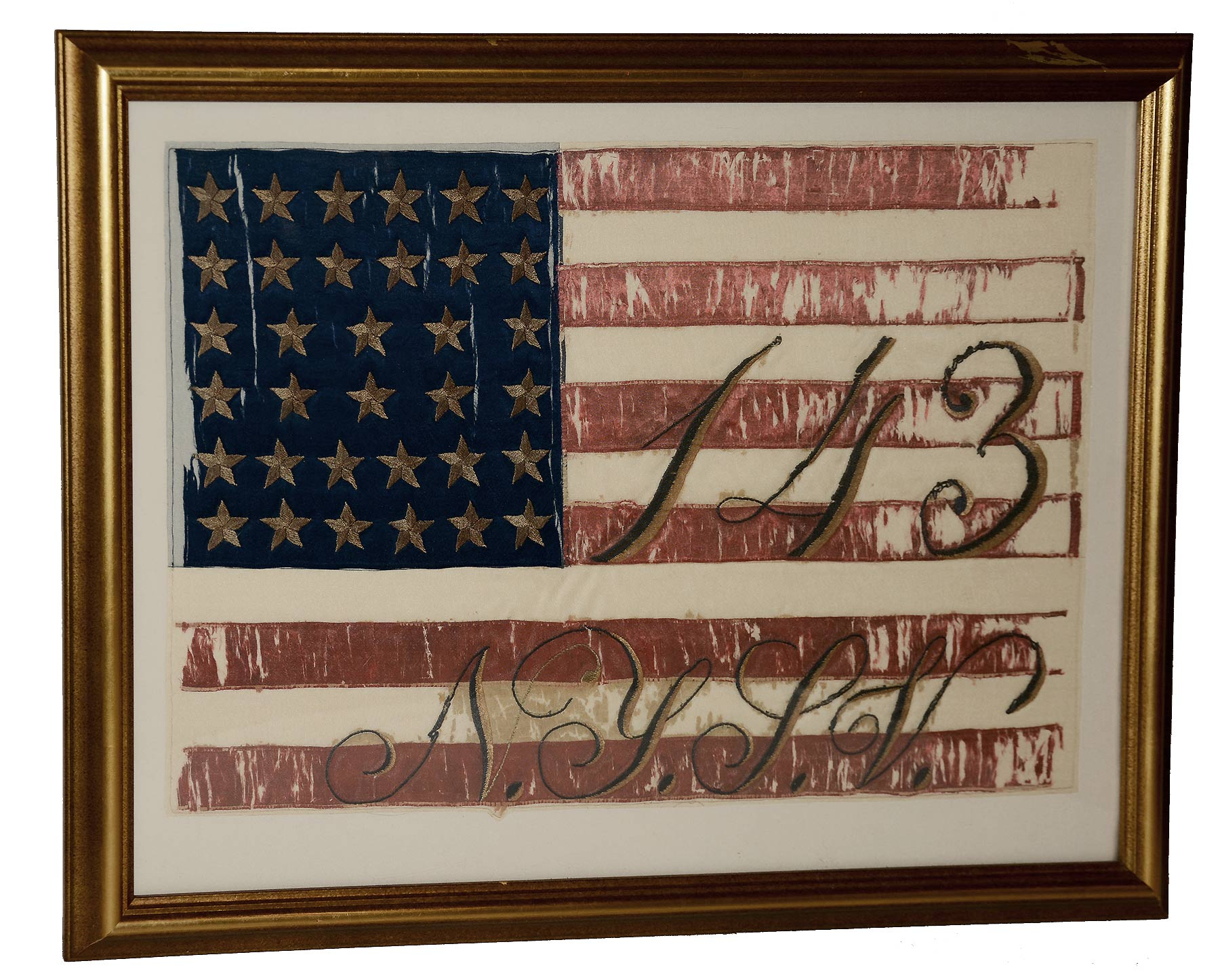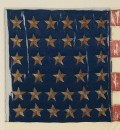site search
online catalog
1862 TIFFANY GENERAL GUIDE FLAG OF THE 143rd NEW YORK

$20,000.00 SOLD
Quantity Available: None
Item Code: 1179-017
This Tiffany-made general guide flag was certainly among the colors presented to the 143rd New York Volunteers upon its formal organization in October 1862. Like the embroidered stars-and-stripes national color presented on that occasion, and now in the New York State collections, this flag has embroidered stars of gold silk and, like other known Tiffany made guide flags, has an embroidered regimental designation, typical of Tiffany, reading “143” in 5” figures, and “N.Y.S.V.” in 3 5/8 – 4”, both in blue and gold silk over the 4th through 7th stripe. Howard Madaus discusses these guide flags in Part II of his four-part series “Camp Colors, General Guide Flags and Flank Markers in the United States Army, 1861-1865” in the journal of the Company of Military Historians, a copy of which is included in our file for this flag. He notes that general guide flags “invariably” were included in presentations of those embroidered national colors. This flag also uses the same star size and arrangement used on other Tiffany guide flags made 1861 to 1863, and the script lettering is identical to that on the guide flags of the 144th and 174th New York, now in the state collections. Those flags are pictured online and are also discussed and identified as Tiffany products by Madaus.
Following the drill manuals in use during the Civil War, a regiment would have two guide flags, carried by sergeants appointed by the regimental colonel and posted in line with the file closers, one on the left of the regiment and one on the right. Madaus also explicitly states, “These two positions were not merely posted for parade drill, but held these positions in combat,” citing the regimental history of the 57th Massachusetts, and the battle of Weldon Railroad in August 1864.
These guide flags were mounted narrow iron rods screwed onto short poles for insertion into the sergeants’s rifle barrels. Those supplied by Tiffany were topped by brass spear-point finials. According to Madaus, the flags themselves measure 17-18 inches on the hoist and 23-24 inches on the fly, including a narrow dark blue sleeve sewn along the leading edge, and from 1861-1863 the embroidered stars were arranged in six rows: 6-6-5-5-6-6. The script style of unit designation is one of three used, the earliest using block letters 4 - 5 1/2” tall, and a later style using white script embroidery on the center stripe only.
This fits all the criteria in layout and style of embroidery. The fly is 22” and the leading edge is 15” long as is, or an estimated 17 3/4” allowing for the missing bottom red and white stripe. The narrow sleeve is missing, but the leading (hoist) edge shows the mostly intact blue canton and all the embroidered stars. The embroidered number and state designation are largely intact. The canton has minor losses and tears. Our photos show the condition of the red stripes, which show some slight fading and evident losses, but are about 70 percent. There are only shreds left of the white silk along the seams, around some of the lettering, and about 6” between the “N” and “Y.” This is not, however, readily noticeable. The flag had originally been framed against a white silk background, which was removed during the cleaning and conservation process outlined in the TPA documents, and has been remounted against a fine cotton fabric that, like the first silk backing, nicely fills in the missing white silk stripes.
The state authorized raising the regiment in August 1862. It recruited in Sullivan County organized at Camp Holly, near Monticello, and mustered into US service for three years on October 8. It left the state Oct. 14 and served in the defenses of Washington until April 1863, and in the defenses of Suffolk until July, during which time it took part in the siege of Suffolk and engagements at Providence Church Road and Bottom’s Bridge. It joined the 11th Corps, Army of the Potomac on July 14, and moved west with that corps to the relief of Rosecrans in September, fighting in the battles around Chattanooga: Wauhatchie and Missionary Ridge, and then took part in the relief of Knoxville. In April 1864 the 11th and 12th Corps combined form the 20th Corps, the 143rd being assigned to the 1st Division, fighting under Sherman in the Atlanta Campaign at Resaca, Dallas, Ackworth, Kennesaw Mountain (Golgotha, Nose’s Creek, Culp’s Farm,) Peach Tree Creek, and at Atlanta, with its heaviest losses at Kennesaw Mountain (76 killed, wounded or missing) and Peachtree Creek (48 killed or wounded.) After the fall of Atlanta it was in the campaign against Savannah with the March to the Sea beginning in November and final taking of Savannah in December. It early 1865 it marched with Sherman again in the Campaign of the Carolinas, and was in the fights at Robertsville, Lawtonville, Averasboro, Bentonville, Goldsboro, Aiken’s Creek, and the Bennet House. It mustered out July 20, 1865, near Washington, having lost 5 officers and 38 men killed or mortally wounded and another 136 wounded who recovered to some degree. Another 221 perished by accident, sickness, or disease- 3 in the hands of the enemy. Only 1 officer and 5 enlisted men were listed as missing during its service.
Formerly in the collections of Texas Civil War Museum, the flag surfaced in 2008 and is accompanied by the dealer’s letter and 2008-2009 receipt, treatment proposal and treatment reports from Textile Preservation Associates, which include before and after photographs and detailed descriptions of condition, treatment, and recommendations for handling and display after their conservation. This is very displayable size, 27 ½” by 21 inches in its gilt frame, has strong eye-appeal, and comes from a fighting regiment with a very active record. [sr] [ph:L]
EXTRA SHIPPING REQUIRED.
~~~~~~~~~~~~~~~~~~~~~~~~~~~~~~~~~~~
THIS ITEM, AS WITH ALL OTHER ITEMS AVAILABLE ON OUR WEB SITE,
MAY BE PURCHASED THROUGH OUR LAYAWAY PROGRAM.
CLICK HERE FOR OUR POLICIES AND TERMS.
THANK YOU!
Inquire About 1862 TIFFANY GENERAL GUIDE FLAG OF THE 143rd NEW YORK
For inquiries, please email us at [email protected]
Most Popular
Historical Firearms Stolen From The National Civil War Museum In Harrisburg, Pa »
Theft From Gravesite Of Gen. John Reynolds »
Selection Of Unframed Prints By Don Troiani »
Fine Condition Brass Infantry Bugle Insignia »
British Imported, Confederate Used Bayonet »
Scarce New Model 1865 Sharps Still In Percussion Near Factory New »
featured item
THEFT REPORTED AT AUTUMN GETTYSBURG SHOW
A vendor at the Autumn Gettysburg Civil War show held at the Allstar Events Complex on Oct. 28-29 reported that a Maryland sword belt plate valued at $3500 was stolen from a display case on Sunday afternoon. The Gettysburg Times published a… . Learn More »
site search
Upcoming Events
May 16 - 18: N-SSA Spring Nationals, Fort Shenandoah, Winchester, VA Learn More »





